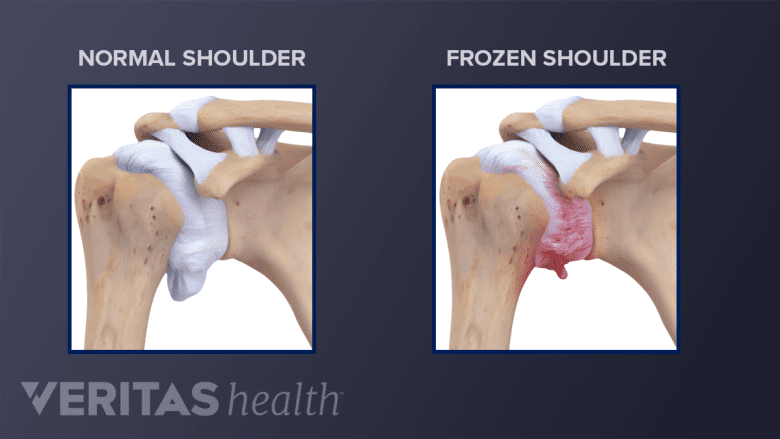People who have frozen shoulder (adhesive capsulitis) are advised to do physical therapy exercises that are physically challenging but do not trigger shoulder pain. The exercises described below are designed for people experiencing moderate to severe frozen shoulder symptoms.
A person is considered to have a moderate to severe case of frozen shoulder if they:1Kelley MJ, Shaffer MA, Kuhn JE, et al. Shoulder pain and mobility deficits: adhesive capsulitis. J Orthop Sports Phys Ther. 2013;43(5):A1-31.
- Report pain higher than a 4 on a scale of 1 to 10
- Experience pain when the shoulder is resting; pain may be irregular or constant
- Are prevented from doing many or most everyday tasks with the affected arm
See What to Know About Frozen Shoulder
People with severe cases may notice that their shoulder’s active range of motion is less than passive range of motion. (Active range of motion is movement a person can perform individually, without assistance.1Kelley MJ, Shaffer MA, Kuhn JE, et al. Shoulder pain and mobility deficits: adhesive capsulitis. J Orthop Sports Phys Ther. 2013;43(5):A1-31.) Because of this fact, many of the recommended exercises require assistance from a therapist, the patient’s healthy arm, or an object such as a cane or light pole.

Frozen shoulder occurs when inflammation of the joint capsule causes the shoulder ligaments to swell and thicken.
In This Article:
- Frozen Shoulder Exercises for Pain Relief
- Exercises for Moderate to Severe Cases of Frozen Shoulder
Supine (lying down) flexion

This exercise uses the patient’s healthy arm for assistance.
- Lay on a flat surface, such as a physical therapy table. The legs are straight, so the body makes a line.
- Relax the arms at the sides of the body.
- Lift the injured arm vertically in the air and backward to the floor with the help of the healthy arm. The healthy arm holds the elbow of the injured arm to help guide the overhead movement.
Keep reaching until a stretch is felt.
Standing Extension

This is exercise uses a light bar or cane.
- Stand and hold the bar or cane horizontally behind the body. The arms are about shoulder width apart. Position the hands so the knuckles face toward the ground.
- Lift the arms in an upward movement until a stretch is felt.
Repeat each exercise about 10 times. Hold each repetition for approximately 1 to 5 seconds. Physicians typically recommend completing physical therapy exercises a couple of times each day.
People with more severe cases of frozen shoulder may also benefit from other treatments, such as electrical stimulation or application of heat to the affected area. A physician or physical therapist may also suggest alternatives to daily activities that may provide comfort and reduce tissue irritation.
Cross the body stretch

- Sit or stand. Both arms are relaxed at the sides of the body.
- Bring the affected arm across the chest. The healthy arm helps this movement by holding the elbow of the affected arm.
- Hold the stretch for 15 to 20 seconds.
Watch: Video: Crossover Shoulder Stretch
This movement should elicit a stretch, not pain.
Doorway external rotation

- Stand near the middle of a doorway, facing one side of the doorframe.
- Bend the affected arm to a 90-degree angle and grab the edge of the doorframe furthest from the body with the hand of the affected arm.
- Rotate the body frontwards, so the backside is now in the doorway.
Hold this stretch for 30 seconds; relax, and repeat.
People with frozen shoulder may also benefit from several other interventions, such as applying heat and/or electrical stimulation for pain relief.
- 1 Kelley MJ, Shaffer MA, Kuhn JE, et al. Shoulder pain and mobility deficits: adhesive capsulitis. J Orthop Sports Phys Ther. 2013;43(5):A1-31.

